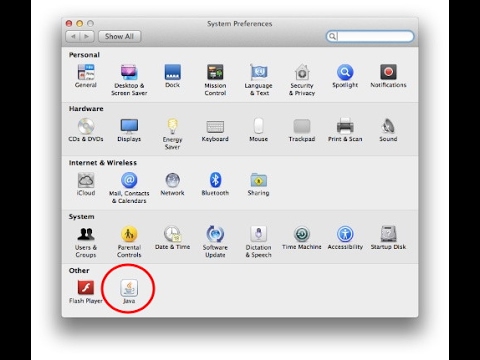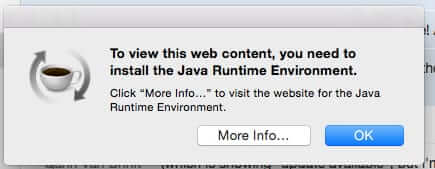- If you only plan to run Java applications, then install the Java Runtime Environment (JRE). The JRE is also referred to as Oracle Java. After you have installed the JRE, you can start Java applets and applications by double-clicking JAR files, JNLP files, and by using the browser. Note that 32-bit browsers, such as Firefox in 32-bit mode,.
- So you just upgraded your Mac (probably to Yosemite) and now you are getting annoying browser errors that say “To view this web content you need to install the Java Runtime Environment.” More annoyingly, after clicking through to Oracle’s Java.com to “Download Java for Mac OS X” and installing it, you still get the error!
- How to check if LibreOffice detected Java Runtime Environment. Before you install Java Runtime Environment to fix the issue, follow the below steps to check whether Java is installed and LibreOffice is able to detect it. Open LibreOffice (calc, Impress, etc). Go to from Menu: Tools - Options - Advanced under LibreOffice.
This topic includes the following sections:
This guide is for installing the Java Runtime Environment (JRE) for browsers. For instructions on.
System Requirements for Installing the JDK on macOS
The following are the system requirements for installing the JDK on macOS:
Any Intel-based computer running macOS.
Administrator privileges.
You cannot install Java for a single user. Installing the JDK on macOS is performed on a systemwide basis for all users. Administrator privileges are required to install the JDK on macOS.
Determining the Default JDK Version on macOS
When starting a Java application through the command line, the system uses the default JDK.

You can determine which version of the JDK is the default by entering java -version in a Terminal window. If the installed version is 14 Interim 0, Update 0, and Patch 0, then you see a string that includes the text 14. For example:
To run a different version of Java, either specify the full path, or use the java_home tool. For example:
$ /usr/libexec/java_home -v 14 --exec javac -version
Installing the JDK on macOS
Install Java Runtime Environment Mac Terminal
- Download the JDK
.dmgfile,jdk-14.interim.update.patch_osx-x64_bin.dmg.Before the file can be downloaded, you must accept the license agreement.
- From either the browser Downloads window or from the file browser, double-click the
.dmgfile to start it.A Finder window appears that contains an icon of an open box and the name of the.pkgfile. - Double-click the
JDK 14.pkgicon to start the installation application.The installation application displays the Introduction window. - Click Continue.
- Click Install. A window appears that displays the message: Installer is trying to install new software. Enter your password to allow this.
- Enter the Administrator user name and password and click Install Software.The software is installed and a confirmation window is displayed.
.dmg file if you want to save disk space. Uninstalling the JDK on macOS
Install A Java Runtime For Mac Os
You must have Administrator privileges.Note:
Do not attempt to uninstall Java by removing the Java tools from /usr/bin. This directory is part of the system software and any changes will be reset by Apple the next time that you perform an update of the OS.
- Go to
/Library/Java/JavaVirtualMachines. - Remove the directory whose name matches the following format by executing the
rmcommand as a root user or by using thesudotool:/Library/Java/JavaVirtualMachines/jdk-14.interim.update.patch.jdkFor example, to uninstall 14 Interim 0 Update 0 Patch 0:
$ rm -rf jdk-14.jdk
Installation FAQ on macOS Platform

This topic provides answers for the following frequently asked questions about installing JDK on macOS computers.
1. How do I find out which version of Java is the system default?

When you run a Java application from the command line, it uses the default JDK. If you do not develop Java applications, then you do not need to worry about this. See Determining the Default JDK Version on macOS.
2. How do I uninstall Java?
See Uninstalling the JDK on macOS.
3. After installing Java for macOS 2012-006, can I continue to use Apple's Java 6 alongside the macOS JDK for Java 14?
If you want to continue to develop with Java 6 using command-line, then you can modify the startup script for your favorite command environment. For bash, use this:
$ export JAVA_HOME=`/usr/libexec/java_home -v 14`
Some applications use /usr/bin/java to call Java. After installing Java for macOS 2012-006, /usr/bin/java will find the newest JDK installed, and will use that for all of the Java-related command-line tools in /usr/bin. You may need to modify those applications to find Java 6, or contact the developer for a newer version of the application.
4. What happened to the Java Preferences app in Application Utilities?

The Java Preferences app was part of the Apple Java installation and is not used by Oracle Java. Therefore, macOS releases from Apple that do not include Apple Java will not include Java Preferences.
Install A Java Runtime For Mac 64-bit
The following are the system requirements for installing the JDK and the JRE on macOS:
Install Java Runtime Mac Os
Any Intel-based computer running macOS.
Administrator privileges.
You cannot install Java for a single user. Installing the JDK and JRE on macOS is performed on a systemwide basis for all users. Administrator privileges are required to install the JDK and JRE on macOS.
When you install the JDK, it also installs the JRE. However, the system will not replace the current JRE with a lower version.
To determine the current JRE version installed on your system, see Determining the JRE Version Installed on macOS. To install an earlier version of the JRE, you must first uninstall the current version. See Uninstalling the JRE on macOS.
When you install the JRE, you can install only one JRE on your system at a time. The system will not install a JRE that has an earlier version than the current version.
To determine the current JRE version installed on your system, see Determining the JRE Version Installed on macOS. To install an earlier version of the JRE, you must first uninstall the current version. See Uninstalling the JRE on macOS.
Note:
Installing a JRE from Oracle will not update
java -versionsymlinks or addjavato your path. To do this, you must install the JDK.
